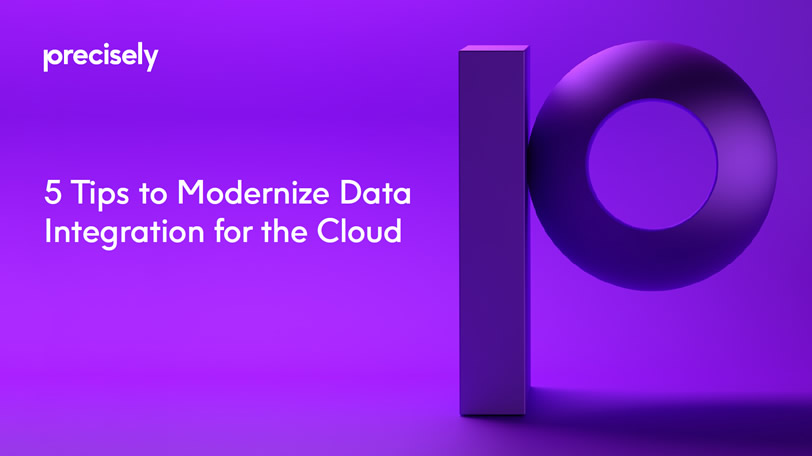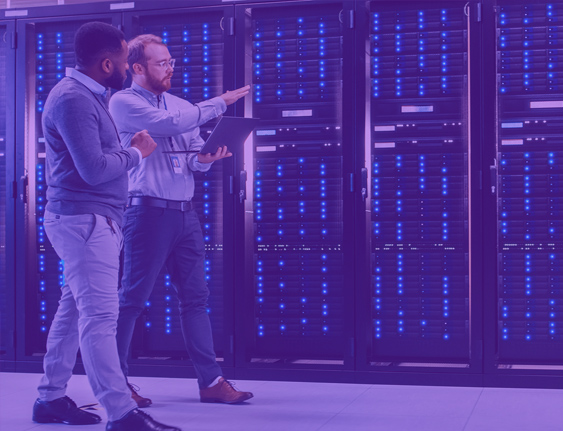eBook
5 Tips to Modernize Data Integration for the Cloud
Read this eBook to learn the best practices for modernizing data integration for the cloud, helping you to ensure project workloads, budgets, and timelines are within your target goals.
Introduction
The terms ‘migration’ and ‘modernization’ are very often used interchangeably. However, in contrast to a migration project, modernization encompasses more transformative changes to applications, infrastructure, data, and business processes to prepare for and take advantage of the latest technologies.
The agility and scalability that the cloud brings are the number one reason organizations are looking to modernize. Operating applications entirely on-premises is rapidly becoming unthinkable. Still, there are reasons why on-premises operations cannot be eliminated, including the restrictions imposed by data residency laws, regulatory requirements, and other specialized security and control mandates.
Such limitations aside, the cloud is the future of work, and modernization is the way to get there. But do not for a minute, imagine that you can ‘modernize’ by just picking up your existing systems and data and dropping them into a cloud platform. This kind of “lift and shift” approach does not work. Instead, carefully planned, incremental, and orchestrated IT modernization is the way forward.
An incremental approach means business operations are supported by a hybrid IT architecture of cloud and on-premises systems. So, strategic planning should focus on identifying and sequencing carefully scoped and bounded projects that will result in your optimal IT configuration over time.

Tip #1: Assess and manage project scope
Modernization requires that you make significant and sometimes radical changes at every level of your IT infrastructure. But every aspect of your business operations must continue unabated throughout the months and perhaps years it takes to achieve your modernization goals.
To smooth out the transition to cloud, you should plan for a careful rollout of projects incrementally over time. Scope out each project carefully to ensure you can keep disruption to a minimum and so that you can handle the workload without overloading staff and spread the related expenses appropriately over time.
For example, properly migrating data to a cloud data warehouse (CDW) requires more than just porting existing database tables into a new environment. You must remodel existing data and new data being generated to meet the data model requirements of the new CDW. Additionally, not all existing data is worth migrating. Avoid applying time and effort to move data that is, realistically, no longer relevant or should sit in an offline archive.
When modeling data for the cloud, keep in mind an additional challenge: Your existing data is, well, most likely of uncertain quality and consistency. If your source data is not clean and consistent, mapping and transforming it to fit the new CDW data model will be a slow and messy process. Because you will be repeating this process for each incremental project, you should design repeatable and reliable data transformation and re-mapping processes.
To help ensure you keep your project workloads, budgets, and timelines within scope, automate these data preparation steps as much as possible. Investing in data collection, cleansing, and transformation tools upfront will pay big dividends in time savings and improve your new cloud systems.

Tip #2: Flexible data migration and integration patterns
Even if your organization’s strategic game plan is to achieve a cloud-native or cloud-first stance, it is not possible to get there in just one or two moves. Specifically, you must expect and plan for incremental changes to IT architecture and the associated data integration patterns.
Also, keep in mind that the architecture of your new or expanding cloud infrastructure will undoubtedly evolve. During your project’s timeline of many months or even years, the available options for cloud platforms and infrastructure will be changing as well. As a result, the details of exactly how you integrate data across your systems will need revision over time.
There will still be data and servers throughout all of this, which will remain on-premises, perhaps permanently.
- Data residency regulations may prevent moving data to the cloud because exactly where the data is physically stored cannot always be guaranteed or even determined.
- Data sensitivity and security concerns may prevent cloud-hosting, such as when an organization is developing products or services for national governments or the military.
The reality for most is that for the foreseeable future, your cloud architecture will always include a hybridized mix of on-premises, third-party SaaS, Platform as a Service (PaaS), and even orchestrated, multi-cloud infrastructure. Successful modernization means considering both current and longer-term architecture evolution and thinking one or two steps beyond the current project’s end state requirements.
When considering data integration tools, be sure you know up-front how much re-development, re-coding, or other customization work will be involved each time you need to re-configure or extend your integration patterns. Ensure you choose tools that make model change and deployment processes easy, modular, and repeatable – especially if you need to reuse the skills you have on your team.
Choosing the right tools saves time and reduces complexity, and it helps to prepare your data integration architectures for what is next.
Tip # 3: Protect sensitive data at all times
The advantages of ninja-level flexibility in collecting, moving, and transforming data during your project can also inadvertently lead to risky lapses in key data management protocols. Data, network, and systems security can all suffer, as can many critical data governance controls. You must ensure that the methods and tools you employ in these processes maintain appropriate data security.
For example, at the beginning of your project, review the data’s related user access permissions. That is the right time to re-align user permissions and access to comply with your new environment’s requirements.

When preparing data, be sure to include de-identifying, masking, or anonymizing data as it is used in data modeling and testing processes. Even though these are temporary processes, working with actual production data can violate data privacy laws. Likewise, when it comes time to move data into your new cloud environment, ensure that you protect sensitive data with appropriate tokenization and encryption methods.
If you are moving data out to the cloud for the first time, know that the standards and methods for managing security in and across cloud environments are very different. Be sure to skill up and understand the requirements for securely integrating cloud systems. Engage with your company’s security professionals and enlist their help to identify and solve the security challenges you will inevitably encounter as you move out to the cloud.
Finally, ensure that while you are renovating and relocating your data, you must maintain the critical data lineage information required for regulatory requirements and operational analytics. Don’t let the accelerated and unusual cycles of data movement, manipulation, and distribution resulting from your project (or your new end-state environment’s configuration) break the critical chain of meta-data needed to prove compliance with data privacy, residency, and security regulations.
Tip # 4: Data access and delivery methods matter
In keeping with the mandate to future-proof your integration patterns, you also need to think through details of exactly how you will access, collect, and deliver data. As you move toward a modernized IT infrastructure, there will be new or increased demands for data throughput volumes and speeds. As a result, it is vital to make sure you have a strategy and answer for the following questions:
- How fast is fast enough for these systems?
- What data is required by each area of the business?
- Does every output require the full transaction data stream or just a filtered subset?
- Can the data be delivered to analytics applications in batches rather than real-time?
When evaluating options for data integration software and tools, consider more than just the core capabilities of data replication for real-time data connections or tools for batch extraction and delivery. Ensure that you can access and integrate across all your platforms, including the legacy systems that are the source for high-volume transaction data.
And ensure that your data integration software will support the data security methods and standards imposed by your cloud-based applications and cloud-platform provider(s), as well as any cloud SEIM systems or third-party security providers.
And finally, ensure that your chosen integration solutions are sufficiently scalable and flexible to handle all new data flows and increasing data volumes that evolving IT solutions generate.


Tip #5: Ensure you have the right teams and tools
One of the most effective ways to ensure that your modernization project runs over budget, comes in late, and fails to deliver on its promised value is to attempt to “save yourself into success.” It is often impossible not to add temporary resources for modernization efforts. It is critical to review your capacities and capabilities and to invest appropriately to meet realistic project requirements.
Here are some areas to evaluate:
Pay special attention to the skill sets and experience levels of your current staff. Deciding whether to assign staff members to the project full-time (and perhaps backfill with temp contract hires) or source and contract skilled specialists to do the job can be tricky. Some mix of these options may be best.
One constraint to adjusting your teams for the project can be staff with specialized or rare skills—case in point: mainframe and IBM Power Systems administrators and programmers. If your infrastructure includes these platforms, you will have a tough time expanding such teams, especially temporarily. Yet every part of your data remediation, migration, and ultimate systems integration with cloud platforms will be dependent upon having their skills and time on the project.
In this case, you should look for software tools and technologies that more easily resourced staff can use to leverage their uniquely skilled colleagues’ skills and guidance, rather than overloading them with project duties on top of their day job.
Migrate to the cloud with Precisely’s Connect
Precisely’s data integration solution, Connect, offers bulk and batch data ingest and data replication capabilities. Connect enables you to access data streams and stores across all your IT platforms for secure data movement and integration during modernization projects. Users of Connect experience a flexible and efficient approach to enterprise-wide data sharing and integration. Connect delivers the capabilities and performance you need, now and for the future:
- Easily integrate applications and data from standalone server environments to the cloud and distributed platforms.
- Visually design workflows once and deploy them anywhere for flexible, repeatable data integration across on-premises, cloud, or hybrid environments – with no changes or tuning required.
- Move workflows from development to production at the click of a button.
- Securely access and deliver the full range of mainframe and IBM Power systems data, including VSAM files, COBOL Copybooks, IMS data, mixed and sequential files, and Db2 – into a cloud or hybrid environment.
- Achieve guaranteed maintenance of end-to-end data lineage for accurate reporting and proven compliance, regardless of the data sources or targets.
- Assure secure integration with native LDAP and Kerberos support and Apache Ranger and Apache Sentry integration.
